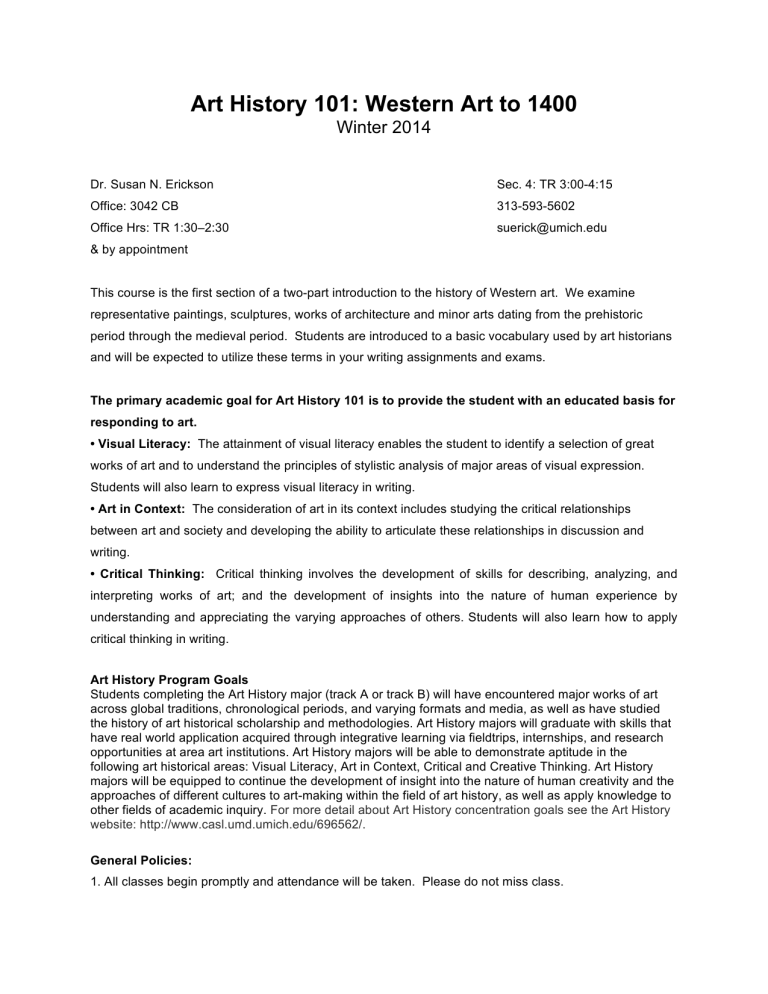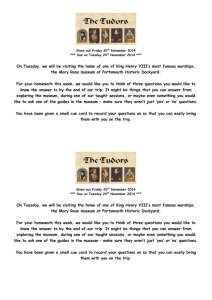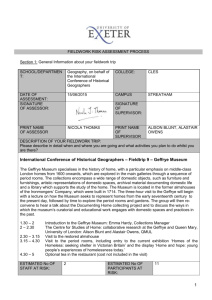Art History 101: Western Art to 1400

Art History 101: Western Art to 1400
Dr. Susan N. Erickson
Winter 2014
Sec. 4: TR 3:00-4:15
Office: 3042 CB
Office Hrs: TR 1:30–2:30
& by appointment
313-593-5602 suerick@umich.edu
This course is the first section of a two-part introduction to the history of Western art. We examine representative paintings, sculptures, works of architecture and minor arts dating from the prehistoric period through the medieval period. Students are introduced to a basic vocabulary used by art historians and will be expected to utilize these terms in your writing assignments and exams.
The primary academic goal for Art History 101 is to provide the student with an educated basis for responding to art.
• Visual Literacy: The attainment of visual literacy enables the student to identify a selection of great works of art and to understand the principles of stylistic analysis of major areas of visual expression.
Students will also learn to express visual literacy in writing.
• Art in Context: The consideration of art in its context includes studying the critical relationships between art and society and developing the ability to articulate these relationships in discussion and writing.
• Critical Thinking: Critical thinking involves the development of skills for describing, analyzing, and interpreting works of art; and the development of insights into the nature of human experience by understanding and appreciating the varying approaches of others.
Students will also learn how to apply critical thinking in writing.
Art History Program Goals
Students completing the Art History major (track A or track B) will have encountered major works of art across global traditions, chronological periods, and varying formats and media, as well as have studied the history of art historical scholarship and methodologies. Art History majors will graduate with skills that have real world application acquired through integrative learning via fieldtrips, internships, and research opportunities at area art institutions. Art History majors will be able to demonstrate aptitude in the following art historical areas: Visual Literacy, Art in Context, Critical and Creative Thinking. Art History majors will be equipped to continue the development of insight into the nature of human creativity and the approaches of different cultures to art-making within the field of art history, as well as apply knowledge to other fields of academic inquiry. For more detail about Art History concentration goals see the Art History website: http://www.casl.umd.umich.edu/696562/.
General Policies:
1. All classes begin promptly and attendance will be taken. Please do not miss class.
2. You must complete the field trip paper and take all exams and quizzes to pass the course. Make up exams will be given only in cases of dire emergency.
3. Please take advantage of my office hours. If these hours are impossible for you, please make an appointment to meet with me.
4. The University will make reasonable accommodations for persons with documented disabilities.
Students need to register with Disability Resource Services (DRS) every semester they are enrolled for classes. DRS is located in Counseling & Support Services, 2157 UC. To be assured of having services when they are needed, students should register no later than the end of the add/drop deadline of each term.
5. Statement on Academic Integrity (Approved August 9, 2000). The University of Michigan-Dearborn values academic honesty and integrity. Each student has a responsibility to understand, accept, and comply with the university's standards of academic conduct as set forth by the Code of Academic
Conduct, as well as policies established by the schools and colleges. Cheating, collusion, misconduct, fabrication, and plagiarism are considered serious offenses. Violations will not be tolerated and may result in penalties up to and including expulsion from the University.
6. Family Educational Rights and Privacy Act: FERPA protects the privacy of student records with a set of guidelines on what information can be shared and how. Instructors cannot provide any grades over telephone or email. Additionally, no grades can be given to relatives of students or to anyone other than the student. http://www.umd.umich.edu/policies_ferpa/
7. Please do not engage in texting or emailing during class—put away all electronic devices before class begins. It is a distraction for your classmates and instructor, and it impairs your concentration during class. Laptop computers or tablets are not permitted to be used unless there is a documented need. If you anticipate an emergency situation that may result in having to leave the classroom to take a phone call, please let me know this could happen, otherwise it is expected that you will remain in the classroom for the entire class period to be considered present for the day.
8. For a 3-credit class like this one, you are expected to spend 9 hours per week reading the text, studying the images, and reviewing lecture notes. If you need academic assistance, including tutoring, you can make an appointment at the Student Success Center, 2nd Floor University Center (313-583-
6776). Be sure to use the course Canvas site at http://canvas.umd.umich.edu/. The syllabus and as well as important announcements will be posted at this site.
Text: Kleiner, Fred S. Gardner’s Art through the Ages: A Global History. 14 th
edition. Book A: Antiquity; and Book B : The Middle Ages . Boston: Wadsworth, Cengage Learning, 2013.
Course Requirements:
Three exams worth 25% each
Quizzes: (dates TBA): 10%
Field trip response paper: 10%
Attendance: 5%
Field Trip: A class field trip will take place in mid March. A map and parking information will be provided.
Attendance is mandatory. You will write a paper comparing an object in the museum to one we have studied in class. Detailed instructions concerning the field trip response paper (3 pages in length) will be discussed in class and posted on Canvas prior to the trip. Due date: TBA.
Exams: There will be three unit exams (noncumulative) during the semester. The exams will be comprised of: 1. slide identification section (including the general title, name of artist if known, period/culture, broad period dates/or date rounded off to the nearest century ); 2 . explanation of terms section ; 3. essay section in which you will be asked to identify the slides and analyze the art works in detail using comparison and contrast; and 4. analysis of an “unknown” work of art section. Correct spelling is necessary to receive full credit in all exams. Please concentrate on doing your best on each of the exams. Many students have found that using flash cards through the term is a beneficial method of studying the works of art. The nature of each quiz will be discussed prior to the date of the quiz.
Grading Scale:
97–100=A+
94–96=A
90–93=A-
87–89=B+
84–86=B
80–83=B-
77–79=C+
74–76=C
70–73=C-
67–69=D+
64–66=D
60–64=D-
Flexible Schedule:
January 7–9:
January 14–16:
January 21–23:
January 28–30:
February 4:
February 6–18:
February 20:
March 3–13:
March 18:
March 20:
March 24–April 1:
April 3:
April 8–10:
April 15–17:
April 24: 3:00-5:00
Introduction & Art before History (Intro/Chapt. 1)
Mesopotamia and Persia (Chapter 2)
Egypt under the Pharaohs (Chapter 3)
The Prehistoric Aegean Art (Chapter 4)
Exam 1
Exam 2
Ancient Greece (Chapter 5)
The Etruscans (Chapter 6)
The Roman Empire (Chapter 7)
Late Antiquity (Chapter 8)
Byzantium (Chapter 9)
Early Medieval Europe (Chapter 11)
Romanesque Europe (Chapter 12)
Gothic Europe (Chapter 13)
Late Medieval Italy (Chapter 14)
Exam 3
INTRODUCTION (page 1 of Study Guide)
Style
Iconography
Context
C
HAPTER
1: A
RT
B
EFORE
H
ISTORY circa (ca.)
BC/BCE and AD/CE
Upper Paleolithic 30,000–8000 BCE
1-5: Nude Woman [ Venus of Willendorf ] (ca. 28,000–25,000
BCE
), from Willendorf,
Austria, limestone
1-6: Woman holding a bison horn (ca. 25,000–20,000
BCE
), from Laussel,
France, Lascaux, painted limestone cave (ca. 16,000–14,000 BCE )
1-1: Hall of the Bulls
1-12: Rhinoceros, wounded man and disemboweled bison [Well scene]
France, Pech-Merle
1-10: Spotted horse and negative handprints (ca. 23,000-22,000
BCE
)
Shaman and animism twisted perspective or composite view optical viewpoint abstraction composition subtractive sculpture relief sculpture and freestanding sculpture
Aboriginal Art, Australia
Neolithic Period 8000–2300 BCE
Neolithic period: Megalithic Culture (ca. 4000–1000
BCE
) megas=great, lithos=stone menhirs henge (cromlech) dolmen
Kelsey Museum of Archaeology Fieldtrip, 434 South State Street, Ann Arbor, 48109
You may want to bring a camera or use your cell camera (do not use flash). The museum does not allow pens to be used in the galleries. Make sure to bring a pencil/paper if not using an electronic device. As we stop in galleries to chat about the art works, be sure not to lean against cases or stand too close to works of art. Please do not touch any of the works of art. If you bring a backpack, it must be checked at the front desk—you also may hang your coat in this area.
You must include a photo of the object you choose. The paper must be at least 3 pages in length and must be typed.
1. Reflect on what you experienced during the fieldtrip. Here are some suggestions. You may have other observations too!
What were your expectations?
How did the fieldtrip meet or differ from your expectations?
After seeing a variety of art works during the trip, which works were most interesting to see in person? Why?
The museum uses a variety of display methods. Consider how these met the needs of the people served by the museum (students of all ages; general public)
Why do you think this field trip is a requirement for this class?
2. Select one object on view in the galleries. a. Record the following information:
Artist’s name if known
Title of the work of art
Country of origin, period, date
Media (materials used to make the work of art)
Size
Accession number
Other information on the label. (do not plagiarize—cite the museum label in your paper)
You may consult the museum’s database to see if there is a photo or additional information. https://www.lsa.umich.edu/kelsey/collections/searchcollections
You will need the information you recorded above (especially the accession number) to conduct a search. The database uses this format for accession numbers: 0000.00.0000. So for example, to find KM 2.1039 you would type in 0000.02.1039
b. Discuss the work as we do in class, and compare this object to a work in your textbook. You may consider a range of issues as you compare and contrast them--not all listed below will apply to the work you choose. You may add other aspects that you feel are relevant. You must thoroughly discuss the work in the museum and the work in your text that you selected.
Size of the work; the shape (for instance of an amphora or statue)
Media; use of color and surface texture
If painted, describe the color, lines and brushwork
Describe the forms used in a composition or decoration; discuss handling of space
If the work represents something in the world, would you say the depiction is realistic or conforms to convention of a style? Give examples.
Discuss the iconography and meaning of the work. What is the function of the object?
Unknown work of art. (Please write complete sentences)
1. Identify and discuss the iconography of the work of art.
2. Discuss the style of the work of art.
3. Which work of art that we studied in class does this one resemble? Why?
4. To the best of your ability, which culture produced this work of art and why? What might be the period and date of production?



